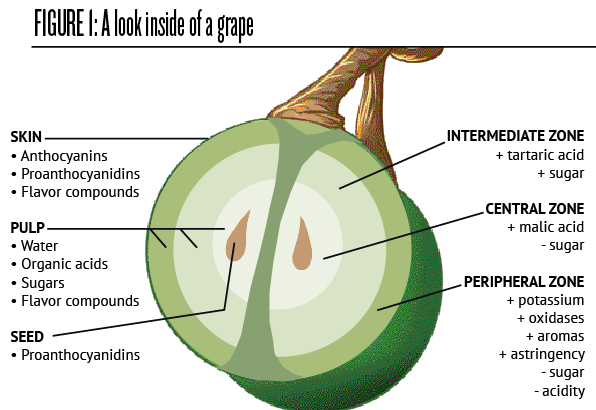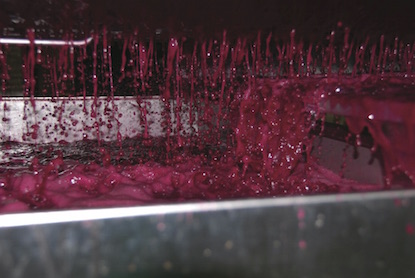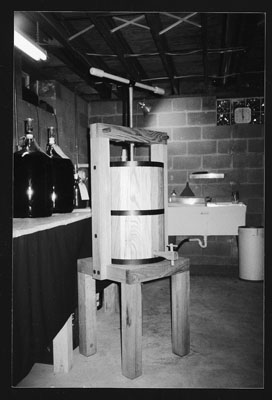 Top Champagne producers do it. High-end Cabernet makers use it for their single vineyard reserve wines. You may have heard or read winemakers talk about how they utilize press cuts to make higher quality wines; white wines with laser focus or red wines with richness and suppleness. Let’s take a look at what is happening during the press cycle to determine if press cuts may elevate your own winemaking.
Top Champagne producers do it. High-end Cabernet makers use it for their single vineyard reserve wines. You may have heard or read winemakers talk about how they utilize press cuts to make higher quality wines; white wines with laser focus or red wines with richness and suppleness. Let’s take a look at what is happening during the press cycle to determine if press cuts may elevate your own winemaking.
When thinking about what pressing and press cuts can do for a wine it is important to understand the fundamental aspects of the grape berry, which come into play during pressing. The grape berry is not uniform, with differences in the type of compounds that can be extracted into juice or wine between the skin, pulp, and seeds (see Fiigure 1 below).
The skin of the berry contains color molecules (anthocyanins), as well as some tannins and tannin building blocks (proanthocyanidins), and aroma compounds. The skin, and the pulp near it, also contain potassium ions that can buffer the weak acids found in grape juice and thus raise the pH of juice. The pulp contains nearly all the juice (water, acids, sugar), and also contains aroma compounds. Finally, the extractable part of seeds contain tannin and tannin building blocks (proanthocyanidins), and perhaps some aroma compounds. The impact of grape aroma compounds and color molecules in wine are relatively straightforward, although there are some aroma molecules locked in the skin structure that we will discuss later. Tannin and tannin building blocks, or precursors, are what give red wines body and astringency and are thus critical to achieving balanced, high-quality reds. Tannins and their precursors, as well as the colorful anthocyanins, are also generally known as “phenolics,” and can bind together to become polyphenolic molecules, which have different sensory properties than the singular compounds.

When pressing raw grapes, the juice from the pulp is the most easily extracted and thus the juice collected at the beginning of pressing is high in sugars, acids, and aroma compounds. As pressing continues the amount of sugar and acid in the juice drops, and the levels of potassium ions and phenolic compounds increase. A more detailed examination of the pulp region is shown on the right side of Figure 1, where changes in the pulp area extracted cause changes in the expressed juice.
Let’s walk through a description of press juice changes for some of the most important chemical parameters in winemaking. These changes have been shown in several research papers, but I’ll be using the research article published in the Journal of Food Engineering “Influence of Two Pressing Processes on the Quality of Must in White Wine Production” by Darias-Martın, Jacinto, Damián Dıaz-González, and Carlos Dıaz-Romero as the main source for my data. Sugar drops over the course of pressing as the easily extracted pulp juice is depleted. The drop can be as much as 1 °Brix over the course of a press run, but even this level of change may not have a significant impact on wine quality given the lower quantity of highly pressed juice to the total volume. Thus sugar is often not the most important parameter to monitor in terms of press juice quality. Juice pH increases over the course of pressing as easily extracted acids are depleted and the potassium ion concentration in the juice increases due to skin maceration. The difference between free run and press fractions may be 0.2 to 0.4 pH units, and thus pH could be an important consideration for some juices/wines already on the high pH end of the goal for that style.
Skin maceration during pressing also causes the phenolic content of the juice to increase. Limiting phenolic compound extraction is perhaps the most important justification for press cuts, as the phenolic concentration in the juice may more than double over the course of the press run. Phenolic compounds may consist of small bitter phenolics and color compounds or color precursors in white juice and red wine, and larger polymeric phenolic compounds (tannin) in red wines. Finally, the total amount of grape solids changes somewhat differently than the other parameters. Grape solids are relatively low in free run juice, increase dramatically when pressing first occurs, then slowly decrease as pressing continues. Turbidity is a measure of the suspended solids in juice or wine, with higher levels believed to hold more oxidative enzymes. These enzymes, combined with increased extraction of phenolic molecules, result in hard pressed juice having more potential for browning reactions.
Changes in the composition of press fractions over time make it possible to adjust the chemical composition of the wine or juice collected by deciding which fractions to include or eliminate. Wine stylistic choices and the raw materials will impact a winemaker’s decision on whether or not to segregate press cuts. For delicate white wines where browning and/or bitter phenolics may pose a problem, selecting out the mid-to-late press cuts could give a higher quality wine, although somewhat limiting yield. An excellent example of this type of press cutting is traditional method sparkling wine production. In this method, only about seventy percent of the total press volume is used for high-quality sparkling production. Another benefit of press fractioning in sparkling production, aided by hand harvesting and whole cluster pressing, is the limited extraction of aroma compounds from the skins, as strong varietal aromas are not desired in high-quality sparkling wine.
For red wines, the free run fraction of a tank often makes up a significant portion of the total tank volume, perhaps up to 75 percent, due to the extended time of skin maceration during fermentation. Thus choosing to collect only free run on reds may still be economically viable. This type of fractioning is especially common with grape varieties that have a strong tannin profile to begin with, such as Cabernet Sauvignon. Use of only free run on these varieties results in a fruitier, more supple wine that may still be in balance without the tannins provided by the press fraction. For varieties that may struggle to achieve a balanced level of tannin extraction, such as Pinot Noir and many hybrid red varieties, use of only free run wine may produce a wine that seems thin and out of balance. These varieties will benefit from adding back some portion of the press fraction wine, and may be at their best when all the press wine has been added back to the blend.
Deciding whether to Press Cut
Another consideration regarding press cutting is the equipment used for pressing. Basket presses common in home wine production are a relatively gentle method of pressing. This means basket pressing produces relatively low yields, and press cuts are probably less useful unless the winemaker is willing to go through the time and trouble of repeatedly breaking up the cake and re-pressing (which would provide for natural press cut breaks). The higher-yielding membrane, or bladder, presses common in commercial production will give more dramatic changes in juice or wine composition over time and thus are perhaps better suited to press cutting than basket presses.
So, how do winemakers determine when to make a press cut? Many winemakers make cuts based on taste. What are they tasting to determine when to cut?
For white juices, the acid and sugar level of the juice are the easiest to taste, as phenolic compounds are often masked by high sugar levels. The acid and sugar may be monitored using a refractometer and a pH meter, if desired. As mentioned earlier, however, the phenolic content and browning potential are probably the most critical components to consider in terms of juice quality. With practice, a winemaker may be able to ascertain changes in bitter and astringent phenolics by taste. One may also monitor the color of the juice as it will become progressively browner over time as the phenolic content increases and oxidation occurs during the press cycle.
For red wines, press cuts are mostly determined by tannin perception. Winemakers monitor the press juice by taste to determine when astringency levels change and when full, grippy tannin sensations give way to harder, more bitter tannins. Red wine changes color during pressing as well, also becoming browner as the press cycle continues. Once press fractions have been stored for a period of time it becomes an interesting benchtop exercise to determine by taste if press cuts should be added back or kept separate from the main lot. It can be difficult to taste young wines and project how the tannin, fruit, and oak profile will change over time, but this is part of the excitement and craft of wine production.
One consideration for press cutting unique to home winemakers is the volume of juice obtained in the different cuts and what will happen with the discarded juice. Commercial producers can find a home for their press cut juices or wines in lower price point blends or different brands. Small production winemakers may have no use for several gallons of press cut juice, in which case it may be tempting to throw this juice away. Another problem may be that separating press cuts leaves the winemaker with many very small-volume lots. This is clearly not ideal as small volumes of juice or wine are much more prone to oxidative damage during processing and storage. In my experience, oxidation is perhaps the number one problem experienced by home winemakers, so keep those carboys topped up to the very top and check free SO2 or periodically add potassium metabisulfite (KMBS)! From a quality perspective it is probably better to forgo press cutting with small lots unless you can quickly determine an add-back ratio and combine the lots into a larger volume before aging. Again, from my experience anything smaller than three gallons (11 L) is very difficult to prevent oxidative damage.
Another option besides simply separating and blending back some portion of the press cut is to treat the press cut with a fining agent to remove undesirable components before blending back to the higher quality juice or wine. Polyvinylpolypyrrolidone (PVPP) is a common fining agent for white wines, removing small phenolic compounds that contribute to browning and bitter taste. Gelatin is also common for white winemaking and removes grape solids and larger tannin polymers responsible for astringency. Egg albumin is a common red wine fining agent for reducing astringency. Detailing all the fining options and products possible is beyond the scope of this article, but press cutting gives the winemaker the option of treating a small portion of the wine lot instead of treating — and perhaps lowering aromatic complexity — in the entire lot.
One final consideration for white wine production is the opposite of press cutting, and that is extended skin contact. Research has shown that some aroma compounds are bound to solid material in the skin of the berry, and that some contact time of the juice with the skins therefore increased the extraction of these aroma molecules into the juice. As such, winemakers looking to maximize grape varietal aromas may crush white varieties and allow them to rest with the skins for a period of time before pressing. This is common for white varieties like Sauvignon Blanc, Riesling, Gewürztraminer, and other whites when high varietal aromas are desired.
Where I live in the Finger Lakes of New York it is common for Riesling producers to perform six to 24 hours of skin contact before pressing. If you’ve been paying attention to the previous discussion one might ask, “What about phenolic pickup during skin contact?” This is certainly a concern, with some winemakers making the decision to PVPP fine their skin contact juice in order to lessen the phenolic and browning precursors obtained during skin contact. One way to limit phenolic pickup in white juices is to perform skin contact and pressing at a low temperature. Phenolic extraction and browning potential are both reduced when skin contact and pressing occur at low temperature.
In summary, it is possible to dial in the aroma and flavor profile of both whites and reds by utilizing press fractioning and benchtop trials to determine the amount of press fraction to include in a final blend. Press fractions also give flexibility in use of fining agents and allow for the production of some wine styles that wouldn’t be possible without splitting up press components. Even if you aren’t completely convinced of the utility of press cuts due to the increased work involved in separating and storing separate lots, it is still interesting to taste samples at different stages of pressing to monitor how the juice is changing over the course of the press run. By gathering this sensory data you may convince yourself that press cutting is worthwhile.







